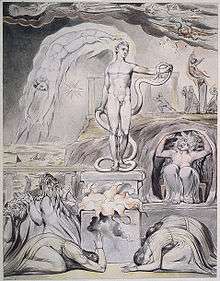On the Morning of Christ's Nativity

On the Morning of Christ's Nativity is a nativity ode written by John Milton in 1629 and published in his Poems of Mr. John Milton (1645). The poem describes Christ's Incarnation and his overthrow of earthly and pagan powers. The poem also connects the Incarnation with Christ's Crucifixion.
Background
Milton composed On the Morning of Christ's Nativity in December 1629, after celebrating reaching the age of maturity in England,[1] in commemoration of Christ's birth. It was written while Charles Diodati, Milton's friend, was composing his own poem, and the poem reflects his sober, contemplative lifestyle in comparison to Diodati's extravagant way of living.[2] The ode was composed during a time in Milton's life that he based his understanding of religion on Scripture, but he was still influenced by myth.[3]
Although the ode was the first poem of Milton's 1645 collection, it was not the first poem that he wrote; many of the Latin and Greek poems included in the 1645 collection were composed during an earlier time. According to Thomas Corns, "Quite probably, its location indicates the poet's assessment of its quality"; this consideration is significant because Humphrey Moseley, an important bookseller, was the publisher of the volume and the ode serves as an introduction to Milton's poetry.[1]
Poem
By Stanza VII, nature stands back, and Christ's birth causes the sun to refuse to take its place:[4]
- And though the shady gloom
- Had given day her room,
- The Sun himself withheld his wonted speed
- And hid his head for shame,
- As his inferior flame;
- He saw a greater sun appear
- Than his bright throne, or burning axle-tree could bear (lines 77–84)
The poem transitions into The Hymn for a new set of stanzas. Christ's role, even as a baby, is apparent and made clear within Stanzas XV and XVI:[5]
- Yea Truth and Justice then
- Will down return to men
- ...
- And Heav'n as at some festival,
- Will open wide the gates of her high palace hall.
- But wisest Fate says no,
- This must not yet be so,
- The babe lies yet in smiling infancy,
- That on the bitter cross
- Must redeem our loss;
- So both himself and us to glorify; (lines 141–142, 147–154)
Themes
The ode with The Passion and Upon the Circumcision form a set of poems that celebrates important Christian events: Christ's birth, the feast of the Circumcision, and Good Friday. The topic of these poems places them within a genre of Christian literature popular during the 17th century and places Milton alongside of poets like John Donne, Richard Crashaw, and George Herbert. However, Milton's poetry reflects the origins of his anti-William Laud and anti-Church of England based religious beliefs.[6]
The poem deals with both the Nativity and the Incarnation of Christ and Milton believed that the two were connected. The Nativity and the Crucifixion represent Christ's purpose as Christ in Milton's poetry, and contemporary poem, because Christ becomes human-like in the Nativity to redeem fallen man and humanity is redeemed when Christ sacrifices himself during the Crucifixion. Milton's reliance on the connection is traditional, and Milton further connects the Nativity with the creation of the world, a theme that is expanded upon later in Book VII of Paradise Lost. Like the other two poems of the set and like other poems at the time, the ode describes a narrator within the poem and experiencing the Nativity.[7]
Critical response
The ode has, according to Thomas Corns, "generally been recognized as Milton's first manifestation of poetic genius and, qualitatively, a poem to be set alongside 'Lycidas' and A Masque presented at Ludlow Castle, 1634 as his most significant poetic works before Paradise Lost.[1] He further claims that the ode "rises in many ways above the rather commonplace achievements of Milton's other devotional poems and stands out from the mass of other early Stuart poems about Christmas."[8]
In music
- In 1928 the first complete setting of Milton's Ode was undertaken by the Cambridge composer Cyril Rootham. The work is set for soli, chorus, semi-chorus and orchestra.
- Portions of the ode are set as part of the text of Ralph Vaughan Williams' Christmas cantata, Hodie (1954).
- Stanza XIII of the Hymn portion of this poem was set by Stephen Paulus in the second movement - "Ring Out! Ye Crystal Spheres" - of his 1990 work "Canticum Novum".
Notes
References
- Corns, Thomas. "'On the Morning of Christ's Nativity', 'Upon the Circumcision' and 'The Passion'" in A Companion to Milton. Ed. Thomas Corns. Oxford: Blackwell Publishing, 2003.
- Shawcross, John. John Milton: The Self and the World. Lexington: University Press of Kentucky, 1993.
External links
-
 Works related to On the Morning of Christ's Nativity at Wikisource
Works related to On the Morning of Christ's Nativity at Wikisource -
 On the Morning of Christ's Nativity public domain audiobook at LibriVox
On the Morning of Christ's Nativity public domain audiobook at LibriVox